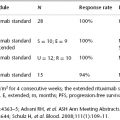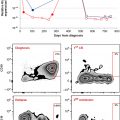Case study 15.1 A 65-year-old white woman is referred by her internist to the hematology clinic for evaluation of worsening symptomatic anemia. She required hospitalization last week for dyspnea and was found to have hemoglobin of 6.9 g/dL. She received 2 units of packed red blood cells (PRBC) for the first time with resolution of her acute symptoms and improvement in her performance status. Gastrointestinal blood loss and nutritional deficiencies were excluded. Her physical exam is unremarkable except for an S3 gallop. Her hemoglobin is 7.3 gm/dl, her mean corpuscular volume (MCV) is 104, her white blood cell (WBC) count is 5500/µL with a normal differential, and her platelet count is 270,000/µL. Her absolute reticulocyte count is 15,000/µL. There is moderate red blood cell anisopoikilocytosis on the peripheral smear. Serum erythropoietin is 10 IU/mL. A bone marrow aspirate and biopsy demonstrate dysplastic features in 20% of the erythroid precursors. Blasts account for 2% of marrow nucleated cells. Iron stores are adequate with less than 5% ring sideroblasts. A fluorescent in situ hybridization panel showed no abnormalities of chromosomes 5q, 7q, 8, or 20q. The cytogenetic analysis showed a normal female karyotype in all 20 metaphases (46XX). She was diagnosed with MDS.
• How will you classify her disease?
The clinical behavior of MDS, in terms of rate of progression of marrow failure, transfusion dependence, risk of progression to AML, and overall survival, varies greatly among patients with this disease. Various classifications have been proposed over the years in an attempt to better prognosticate patient outcomes. The French-American-British (FAB) classification is the oldest scheme for the classification of MDS (Table 15.1 ). It divides MDS into five subtypes based on the bone marrow and peripheral blood morphology, namely, the percentage of blasts in the peripheral blood and bone marrow, peripheral blood absolute monocytosis, and the presence or absence of ring sideroblasts. She has refractory anemia (RA). However, other features of the disease, including cytogenetic abnormalities, were not included, mostly due to our very limited knowledge of these changes when the FAB classification system was developed.
Table 15.1 et al . Br J Haematol. 1982;51(2):189–99. Reproduced with permission of John Wiley & Sons Ltd).
Peripheral blood Bone marrow Refractory anemia (RA) Blasts ≤1%9 /l Blasts <5% Refractory anemia with ringed sideroblasts (RARS) Blasts ≤1%9 /l Blasts <5% Refractory anemia with excess blasts (RAEB) Blasts <5%9 /l Blasts ≥5–≤20% Chronic myelomonocytic leukaemia (CMML) Monocytes >1 × 109 /l Blasts ≤20% Refractory anemia with excess blasts in transformation (RAEB-t) Blasts ≥5% Or blasts >20–≤30%
The World Health Organization (WHO) reclassified MDS in 2000 and 2008 (Table 15.2 ) based on clinical data, but the system remained predominantly a morphologic classification. The WHO 2008 classification system subclassifies the low-grade MDS (i.e., less than 5% marrow blasts) based on the number of lineages demonstrating dysplastic changes. Patients with refractory cytopenia with unilineage dysplasia (RCUD), including RA, refractory neutropenia, refractory thrombocytopenia, and RA with ring sideroblasts (RARS), have a more favorable outcome compared with those low-grade MDS patients with multilineage dysplasia, including refractory cytopenias with multilineage dysplasia (RCMD) and RCMD with ring sideroblasts. It lowers the blast threshold for the diagnosis of AML from 30% to 20%, eliminating the diagnosis of refractory anemia with excess blasts in transformation (RAEB-t) by FAB criteria. Refractory anemia with excess blasts has been subdivided into RAEB1 (5–9% marrow blasts) and RAEB2 (10–19% marrow blasts), again based on differences in prognosis. The 2008 WHO classification also adds a category for unclassifiable cases that do not fit into other categories and for atypical presentations of MDS, such as those with extensive fibrosis. The WHO classification does include one genetically defined subtype, MDS with isolated del(5q). She has RA by the WHO classification as well.
Table 15.2
Disease Blood findings Bone marrow findings Refractory anemia (RA) Anemia Erythroid dysplasia only Refractory anemia with ringed sideroblasts (RARS) Anemia ≥15% ringed sideroblasts Refractory cytopenia with multilineage dysplasia (RCMD) Cytopenias (bicytopenia or pancytopenia)9 /L monocytes Dysplasia in ≥10% of the cells of two or more myeloid cell lines Refractory cytopenia with multilineage dysplasia and ringed sideroblasts (RCMD-RS) Cytopenias (bicytopenia or pancytopenia)9 /L monocytes Dysplasia in ≥10% of the cells in two or more myeloid cell lines Refractory anemia with excess blasts-1 (RAEB1) Cytopenias9 /L monocytes Unilineage or multilineage dysplasia Refractory anemia with excess blasts-2 (RAEB2) Cytopenias9 /L monocytes Unilineage or multilineage dysplasia Myelodysplastic syndrome—unclassified (MDSU) Cytopenias Unilineage dysplasia: one myeloid cell line MDS associated with isolated del(5q) Anemia Normal to increased megakaryocytes with hypolobated nuclei
However, aside from marrow morphology, both the FAB and WHO systems do not include factors that have been shown to affect the course of MDS. Many features have been shown to influence MDS outcome, including patient age, comorbid conditions, performance status, transfusion dependence, LDH, cytogenetics, and marrow fibrosis. Multivariate analyses have demonstrated the significant impact of marrow cytogenetic abnormalities on the prognosis of patients with MDS.1 A clonal abnormality is defined by the International System for Human Cytogenetic Nomenclature as two or more cells with the same chromosome gain or structural rearrangement, or three cells with the same chromosome loss.
The most widely accepted MDS risk assessment model is the International Prognostic Scoring System (IPSS), which uses marrow blasts, cytogenetic changes, and the number of peripheral blood cytopenias to classify MDS cases into four prognostic subgroups: low risk (score: 0), intermediate-1 risk (score: 0.5–1.0), intermediate-2 risk (score: 1.5–2.0), and high risk (score: ≥2.5). The system was developed prior to the WHO classification and therefore still incorporated 21–30% marrow blasts. The cytogenetics were broadly divided into good, with normal, −Y, del(5q), and del(20q); poor, with complex (≥3 abnormalities) or chromosome 7 anomalies; and intermediate risk, which includes all other abnormalities. It is also important to realize that the model only applies to patients at the time of diagnosis with de novo MDS who received supportive care alone. Therapy-related MDS generally has a much worse prognosis than de novo disease.
These risk groups showed significantly different overall survival and risk of acute leukemia transformation. Median survival for low-risk patients was 5.7 years, and it was 3.5 years for intermediate-1 risk, 1.2 years for intermediate-2 risk, and 0.4 years for the high-risk disease group.
The IPSS has several limitations, the most important of which is that it does not characterize patients with lower-risk disease (IPSS low or intermediate-1 risk) very well in terms of prognosis. This group accounts for two-thirds of patients with MDS, some of whom may possibly benefit from early intervention. As this system was developed at initial diagnosis in patients with MDS, it cannot be used reliably during the course of the disease and its evolution. Furthermore, the model was based on cytogenetic information from only 816 patients, two-thirds of whom had a normal diploid karyotype. The prognostic significance of less common single or double cytogenetic changes [i.e., other than del(5q), chromosome 7 abnormalities, trisomy 8, del(20q), and –Y] could not be accurately assessed; these were arbitrarily included in the intermediate-risk karyotype group.
Schanz et al . (2011) evaluated a greater number of MDS cases (2902 patients) with cytogenetic data from several different groups, and they were able to propose a new comprehensive cytogenetic scoring system. This data set allowed the investigators to estimate the prognostic impact of less common single and double cytogenetic changes. Nineteen cytogenetic abnormalities were identified. Cytogenetic categories have a more significant effect on survival compared with marrow blast percentage. They divided these cytogenetic abnormalities into five prognostic subgroups: very good, good, intermediate, poor, and very poor.
This new cytogenetic scoring system provided the foundation for the revised IPSS (IPSS-R) (Table 15.3 ). The major differences between the IPSS-R and its predecessor include five cytogenetic subgroups rather than three, classification of the less common cytogenetic abnormalities, division of the lowest marrow blast subgroup into <2% blasts and 2 to <5% blasts, and weights for the degree of individual cytopenias. A significant proportion of patients within the IPSS lower-risk group (27%) would be “upstaged” in the IPSS-R classification, while 18% in the higher risk group would be “downstaged” by IPSS-R.
Table 15.3 http://www.mds-foundation.org/wp-content/uploads/2011/12/2-RevisedInternationalPrognosticScoringSystem.pdf ).
The score by IPSS-R correlated with the risk of dying and risk of leukemic transformation (Table 15.4 ).
Table 15.4 http://www.mds-foundation.org/wp-content/uploads/2011/12/2-RevisedInternationalPrognosticScoringSystem.pdf ).
Thus, based on the above classification systems, this patient would be classified as low risk with a total score of 0 by IPSS (blasts <5%, 0; normal cytogenetics, 0; and 0/1 cytopenia, 0) with a median survival of 5.7 years. Using the IPSS-R, she would have a score of 3.5, placing her in the intermediate-risk category with a predicted survival of 3 years. Her physician chooses to treat her with an erythropoietic stimulating agent, and she becomes transfusion independent.







